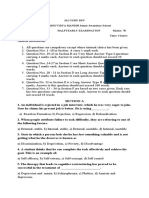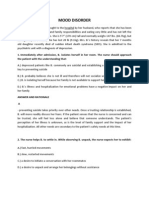CBSE Last Year Paper
Class – 12 Physicology
2016 Outside Delhi (Set 1) (Theory)
Time allowed : 3 hours / Maximum Marks : 70
General Instructions:
(i) All questions are compulsory.
(ii) Marks for each question are indicated against it.
(iii) Answers should be brief and to the point.
(iv) Questions no. 1 - 10 in Part A has Learning Checks (very short answer type) questions
carrying 1 mark each. You are required to answer them as directed.
(v) Questions no. 11 - 16 in Part B are Very Short Answer type questions carrying 2 marks
each. Answer to each question should not exceed 30 words.
(vi) Questions no. 17 - 20 in Part C are Short Answer Type I questions carrying 3 marks each.
Answer to each question should not exceed 60 words.
(vii) Questions no. 21 - 26 in Part D are Short Answer Type II questions carrying 4 marks
each. Answer to each question should not exceed 100 words.
(viii) Questions no. 27 - 28 in Part E are Long Answer Type questions carrying 6 marks each.
Answer to each question should not exceed 200 words.
PART – A
1. The _________ approach considers intelligence as an aggregate of abilities.
Ans. Psychometric approach.
2. Personality characterised by proneness to depression is classified as type _________
personality.
Ans. Type D.
3. Personality traits of hardiness are control, commitment and ________.
1/8
�Ans. challenge.
4. Mood disorders in which both mania and depression are alternatively present is
known as _________.
Ans. Bipolar mood disorder.
5. Repeated association of undesired response with an aversive consequence is called
_________ conditioning.
Ans. Aversive.
6. Assigning causes to the behaviour shown in specific social situations is known as
_________.
Ans. Attribution.
7. Binding or mutual attraction among group members is referred to as _________.
Ans. Cohesiveness.
8. Act of aggression meant to obtain a certain goal or object is known as _________
aggression.
Ans. Instrumental.
9. Non-verbal acts in any talk are referred to as _________.
Ans. Body language.
10. Ability to organise and monitor our own behaviour is known as _________.
Ans. Self regulation.
PART – B
11. Explain the term giftedness.
Ans. Giftedness is an exceptional general ability shown in superior performance in wide
variety of areas (or any other authentic definition)
12. Explain the term conflict.
Ans. A state of disturbance or tension resulting from opposing motives, drives, needs or
goals.
13. What is self-actualisation?
Ans. Self actualization is a state in which people have reached their own fullest potential
2/8
�OR Self actualization is defined as an innate or inborn force that moves the person to become
more complex, balanced and integrated i.e. achieving complexity and balance without being
fragmented.
14. Explain the term ingroup.
Ans. Ingroup refers to one’s own group. For ingroup members, we use word ‘we’. Persons in
the ingroup are generally supposed to be similar, are viewed favourably and have desirable
traits.
15. What is the spiritual perspective of human - environment relationship ?
Ans. The spiritual perspective of human environment relationship refers to the view of the
environment as something to be respected and valued rather than exploited. It implies that
human being recognise the interdependent relationship between themselves and the
environment.
16. Explain the term empathy.
Ans. Empathy is present when one is able to understand the plight of another person and
feel like the other person. It means understanding things from the other person’s shoes/
perspective.
OR
Empathy is the ability of a person / counsellor to understand the feeling of another person
from her / his perspective. It is like stepping into someone’s shoes and trying to understand
the pain and troubled feelings of the other person.
PART – C
17. Explain bipolar mood disorder.
Ans. Bipolar mood disorder is also known as manic depressive disorder. Bipolar disorder is
a mood disorder in which mania and depression do occur alternatively / cyclic. Mania and
depression are sometimes interrupted by normal mood. Lifetime risk of a suicide attempt is
the highest in this disorder. (Symptoms of mania and depression may also be stated.)
18. Discuss impression formation.
Ans. Impression formation Definition: When we meet people we make inferences about
their personal qualities. This is called impression formation It involves two individuals –
perceiver and target
3/8
�OR
The process of impression formation consists of the following three sub processes
1. Selection
2. Organisations
3. Inferences
(Brief explanation of all points)
19. Explain three skills of communication.
Ans. Skills of communication
a) Speaking
b) Active listening
c) Body language
(explanation of each)
20. Discuss the effects of noise on human behaviour.
Ans. Effects of noise on human behavior
a) Effects on performance
b) Effects on concentration
c) Effects on mental health (as well)
d) Effects on emotions
(explanation of any three)
OR
Explain any three situational factors leading to aggression.
Ans. Three situational factors leading to aggression are
a) Learning
b) Observing an aggressive model
c) Anger – provoking action by others
d) Availability of weapons of aggression
e) Cultural factors
(explanation of any three)
PART – D
21. Explain the humanistic approach to study personality.
4/8
�Ans. Humanistic approach to personality – proposed by Rogers
• Fully functioning person – fulfillment is the motivating force for personality development
• Two assumptions by Rogers
- Behavior is goal-directed or worthwhile
- People use adaptive self-actualizing behavior
• Discrepancy between the real self and ideal self often results in unhappiness and
dissatisfaction
• An atmosphere of unconditional positive regard must be created in order to ensure
enhancement of people’s self-concept.
• This theory emphasizes the significance of positive aspects of life
• Diagram on page 41 could be included in the answer (any four points)
According to Abraham Maslow
• Attainment of self actualization
• Optimistic and positive view of man (explanation)
22. Discuss Erikson’s concept of identity crisis.
Ans. Erickson’s concept of identity crisis It is post Freudian approach Erickson’s theory
lays stress on rational conscious ego processes in personality development in his theory
development is viewed as life long process and ego identity is granted a central place in this
process. His concept of identity crisis of adolescence age has drawn considerable attention
Erickson argues that young people must generate for themselves perspective and a direction
that can give them a meaningful sense of unity and purpose
23. Describe any four techniques for managing stress.
Ans. Four techniques for managing stress
• Relaxation technique
• Meditation procedures
• Biofeedback
• Creative visualisation
• Cognitive behavioural techniques
• Exercises
(explanation of any four)
24. Explain the nature of therapeutic relationship between the client and the therapist.
Ans. • Therapeutic relationship refers to a typical relationship between client and
therapist.
5/8
�• Therapeutic relationship is basic requirement of psychotherapy.
• It is helping, trusting, confiding, dynamic professional relationship
• It has two components. It is contractual in nature. It is for limited period of time.
• The goal of therapeutic relationship is to establish the rapport, winning the trust of the
client.
• By providing unconditional positive regard, empathy, permissive environment, genuine
concern and freedom of expression.
25. Explain any two strategies for handling prejudice.
Ans. Strategies for handling prejudices
• Education and information dissemination
- For correcting stereotypes
- Handling strong ingroup bias
• Encouraging intergroup contact
- Direct communication
- Removal of mistrust between the group
- Finding positive qualities in the out group
• Highlighting individual identity rather than group identity (any two points)
26. Describe any four strategies for resolving conflicts.
Ans. Strategies for resolving conflicts
• Introduction of superordinate goals
• Altering perceptions
• Increasing intergroup contacts
• Redrawing group boundaries
• Negotiations
• Structural solutions
• Respect for other group’s norms (explanation of any four)
OR
Enumerate the four elements of group structure.
Ans. Four elements of group structure are
• Role
• Norms
• Status
• Cohesiveness (explanation of all points)
6/8
�27. Explain the term intelligence. Describe the triachic theory of intelligence.
Ans. Intelligence Wechsler defined intelligence as the global capacity of an individual to
think rationally, act purposefully and to deal effectively with his / her environment (or any
other suitable definition)
Triarchic theory of intelligence Robert Sternberg proposed the triarchic theory of
intelligence. Sternberg views intelligence as the ability to adapt, to shape and select
environment to accomplish one’s goals and those of one’s society and culture. According to
this theory there are three basic types of intelligence.
• Componential intelligence
- metacomponents
- performance components
- knowledge acquisition components
• Experiential intelligence
• Contextual intelligence (explanation of all)
OR
Explain briefly the theory of multiple intelligences.
Ans. Theory of multiple intelligence Howard Gardner proposed the theory of multiple
intelligence. According to him, intelligence is not a single identity rather distinct types of
intelligence exist. Eight types of intelligence are:
• Linguistic
• Logical mathematical
• Spatial
• Musical
• Bodily kinaesthetic
• Interpersonal
• Intrapersonal
• Naturalistic (brief explanation of each)
28. Explain the term dissociation. Discuss its various forms.
Ans. Dissociation Severance of the connection between ideas and emotions. Involves feelings
of unreality, estrangement, depersonalisation and sometimes a loss or shift of identity.
Forms of dissociative disorders are
• Dissociative amnesia
• Dissociative fugue
7/8
�• Dissociative identity disorder
• Depersonalisation (explanation of each)
OR
Explain the diathesis-stress model of abnormal behaviour giving examples from daily
life.
Ans. Diathesis stress model This model states that psychological disorders develop when a
diathesis (biological aberration to the disorder) is set off by a stressful situation. This model
has three components
• Presence of some biological aberration which may be inherited
• Diathesis may carry predisposition or vulnerability to develop a psychological disorder
• Presence of pathogenic stressors i.e. factors that may lead to psychopathology
• any suitable example from daily life
8/8























































































